Module4 Unit 1 I haven't done much exercise since I got my computer 语言点课件(共11张PPT)
文档属性
| 名称 | Module4 Unit 1 I haven't done much exercise since I got my computer 语言点课件(共11张PPT) | 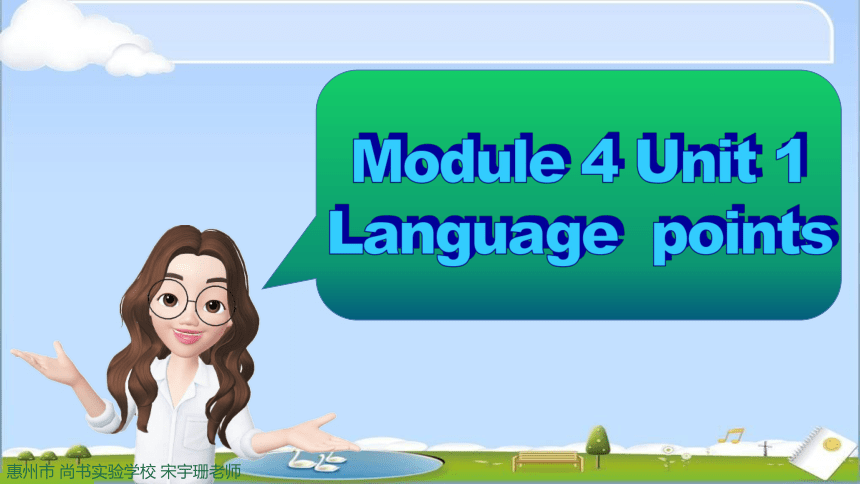 | |
| 格式 | zip | ||
| 文件大小 | 2.2MB | ||
| 资源类型 | 教案 | ||
| 版本资源 | 外研版 | ||
| 科目 | 英语 | ||
| 更新时间 | 2020-03-21 12:47:04 | ||
图片预览

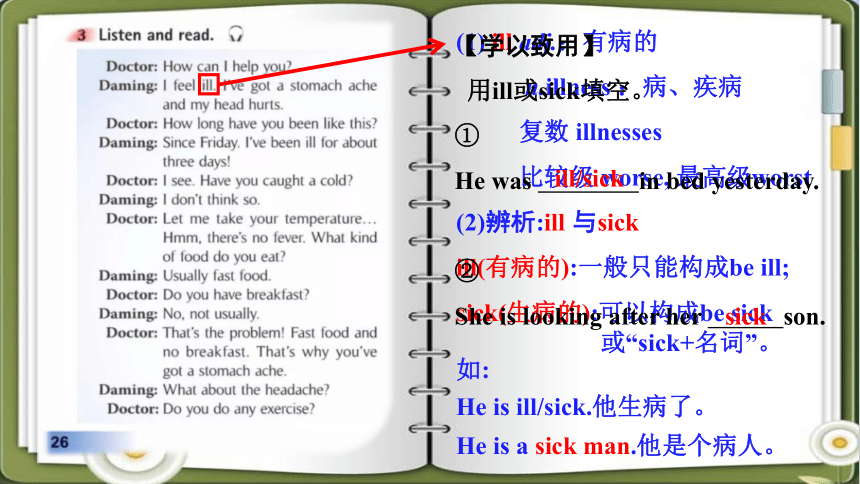
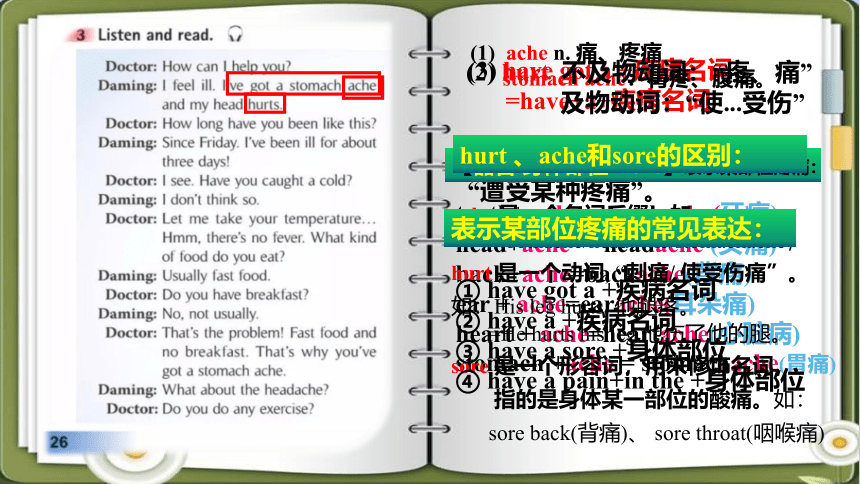
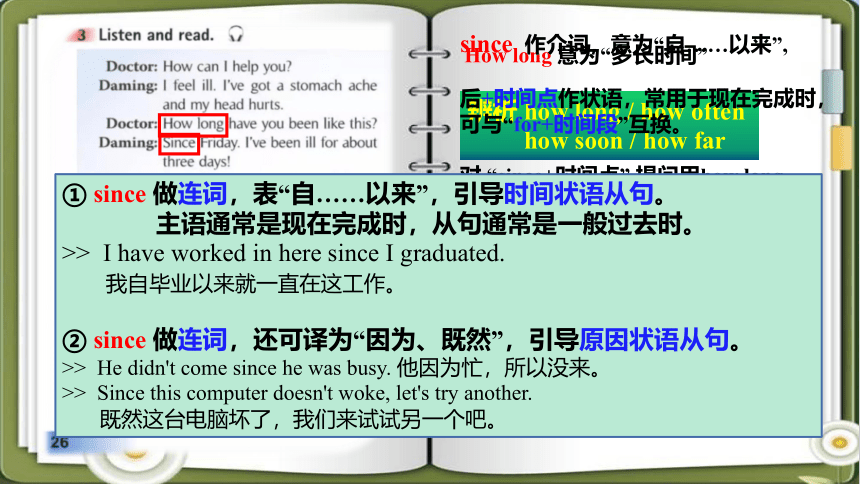
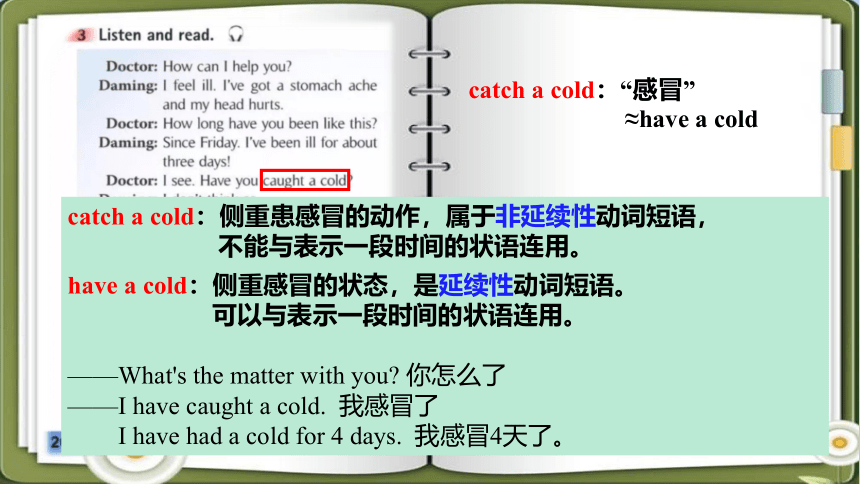
文档简介
(共11张PPT)
Module 4 Unit 1
Language points
惠州市 尚书实验学校 宋宇珊老师
(1) ill adj.:有病的
n.illness :病、疾病
复数 illnesses
比较级 worse, 最高级worst
(2)辨析:ill 与sick
ill(有病的):一般只能构成be ill;
sick(生病的):可以构成be sick
或“sick+名词”。
如:
He is ill/sick.他生病了。
He is a sick man.他是个病人。
【学以致用】
用ill或sick填空。
①
He was in bed yesterday.
?
②
She is looking after her son.?
ill/sick
sick
tooth+ ache = toothache(牙痛)
head+ache = headache (头痛)
back+ache=backache(背痛)
ear + ache=earache(耳朵痛)
heart + ache=heartache(心脏病)
stomach +ache = stomachache(胃痛)
(3) have got a +疾病名词
=have+a+疾病名词
表示”患上某种疾病”或
“遭受某种疼痛”。
(1) ache n. 痛、疼痛
stomach ache:胃疼、腹痛。
【器官/身体部位+ache】表示某部位疼痛:
hurt 、ache和sore的区别:
(2) hurt 不及物动词:“疼、痛”
及物动词:“使...受伤”
ache 是一个名词后缀,如:
toothache/headache/stomachache;
hurt 是一个动词, “刺痛/ 使受伤痛”。
如:His leg hurts. 他腿疼。
=He hurts his leg.他伤了他的腿。
sore 是一个形容词,用来修饰名词,
指的是身体某一部位的酸痛。如:
sore back(背痛)、 sore throat(咽喉痛)
① have got a +疾病名词
② have a +疾病名词
③ have a sore +身体部位
④ have a pain+in the +身体部位
表示某部位疼痛的常见表达:
How long 意为“多长时间”
辨析 how long / how often
how soon / how far
how long: “多长时间”,回答用“for”/ “since”引导的时间状语。
how often: “多久一次”,指动作的频率。
how soon: “还要多久”,常用于将来时态,回答用“in+一段时间”。
how far: “多远”,用于询问路程/距离
since 作介词,意为“自……以来”,
后+时间点作状语,常用于现在完成时,可与“for+时间段”互换。
对 “since+时间点” 提问用how long。
① since 做连词,表“自……以来”,引导时间状语从句。
主语通常是现在完成时,从句通常是一般过去时。
>> I have worked in here since I graduated.
我自毕业以来就一直在这工作。
② since 做连词,还可译为“因为、既然”,引导原因状语从句。
>> He didn't come since he was busy. 他因为忙,所以没来。
>> Since this computer doesn't woke, let's try another.
既然这台电脑坏了,我们来试试另一个吧。
catch a cold:“感冒”
≈have a cold
catch a cold:侧重患感冒的动作,属于非延续性动词短语,
不能与表示一段时间的状语连用。
have a cold:侧重感冒的状态,是延续性动词短语。
可以与表示一段时间的状语连用。
——What's the matter with you? 你怎么了
——I have caught a cold. 我感冒了
I have had a cold for 4 days. 我感冒4天了。
与take有关的短语:
(1) take sb.’s temperature
意为“量某人的体温”。
(2) take v.
意为(用机器) 测定、量取”。
take care of 照顾
take medicine 服药
take a walk 散步
take a look 看一看
take a bath 洗澡
take place 发生,举行,进行
take off 脱下, (飞机)起飞
take photos / pictures 拍照
take a message 捎口信
take away 夺去,拿走
exercise的其他用法:
exercise un. 意为“锻炼、运动。
常用搭配:do /take exercise
exercise:
不及物动词:意为“运动、锻炼”
可数名词:表示“(保持健康/培训技能的)一套动作、训练活动、练习”
>> I think you should exercise more. 我认为应该多锻炼。
>> We should do morning exercise everyday. 我们应该每天做操。
辨析:too much / too many / much too
too much 意为“太多”
too much 太多 修饰不可数名词
单独使用,位于动词之后
too many 太多 修饰可数名词复数
much too 太 修饰adj. /adv
harmful 形容词:有害的
常用搭配:
be harmful to: 对…有害
= do harm to
= be bad for
吸烟对我们的健康有害:
Smoking is harmful to our health.
=Smoking does harm to our health.
=Smoking is bad for our health.
一次:once
两次:twice
三次或三次以上:“基数词+times”
three times a day: 一天三次
其中time用作可数名词,
意为:“次、回”
Thank you!
Module 4 Unit 1
Language points
惠州市 尚书实验学校 宋宇珊老师
(1) ill adj.:有病的
n.illness :病、疾病
复数 illnesses
比较级 worse, 最高级worst
(2)辨析:ill 与sick
ill(有病的):一般只能构成be ill;
sick(生病的):可以构成be sick
或“sick+名词”。
如:
He is ill/sick.他生病了。
He is a sick man.他是个病人。
【学以致用】
用ill或sick填空。
①
He was in bed yesterday.
?
②
She is looking after her son.?
ill/sick
sick
tooth+ ache = toothache(牙痛)
head+ache = headache (头痛)
back+ache=backache(背痛)
ear + ache=earache(耳朵痛)
heart + ache=heartache(心脏病)
stomach +ache = stomachache(胃痛)
(3) have got a +疾病名词
=have+a+疾病名词
表示”患上某种疾病”或
“遭受某种疼痛”。
(1) ache n. 痛、疼痛
stomach ache:胃疼、腹痛。
【器官/身体部位+ache】表示某部位疼痛:
hurt 、ache和sore的区别:
(2) hurt 不及物动词:“疼、痛”
及物动词:“使...受伤”
ache 是一个名词后缀,如:
toothache/headache/stomachache;
hurt 是一个动词, “刺痛/ 使受伤痛”。
如:His leg hurts. 他腿疼。
=He hurts his leg.他伤了他的腿。
sore 是一个形容词,用来修饰名词,
指的是身体某一部位的酸痛。如:
sore back(背痛)、 sore throat(咽喉痛)
① have got a +疾病名词
② have a +疾病名词
③ have a sore +身体部位
④ have a pain+in the +身体部位
表示某部位疼痛的常见表达:
How long 意为“多长时间”
辨析 how long / how often
how soon / how far
how long: “多长时间”,回答用“for”/ “since”引导的时间状语。
how often: “多久一次”,指动作的频率。
how soon: “还要多久”,常用于将来时态,回答用“in+一段时间”。
how far: “多远”,用于询问路程/距离
since 作介词,意为“自……以来”,
后+时间点作状语,常用于现在完成时,可与“for+时间段”互换。
对 “since+时间点” 提问用how long。
① since 做连词,表“自……以来”,引导时间状语从句。
主语通常是现在完成时,从句通常是一般过去时。
>> I have worked in here since I graduated.
我自毕业以来就一直在这工作。
② since 做连词,还可译为“因为、既然”,引导原因状语从句。
>> He didn't come since he was busy. 他因为忙,所以没来。
>> Since this computer doesn't woke, let's try another.
既然这台电脑坏了,我们来试试另一个吧。
catch a cold:“感冒”
≈have a cold
catch a cold:侧重患感冒的动作,属于非延续性动词短语,
不能与表示一段时间的状语连用。
have a cold:侧重感冒的状态,是延续性动词短语。
可以与表示一段时间的状语连用。
——What's the matter with you? 你怎么了
——I have caught a cold. 我感冒了
I have had a cold for 4 days. 我感冒4天了。
与take有关的短语:
(1) take sb.’s temperature
意为“量某人的体温”。
(2) take v.
意为(用机器) 测定、量取”。
take care of 照顾
take medicine 服药
take a walk 散步
take a look 看一看
take a bath 洗澡
take place 发生,举行,进行
take off 脱下, (飞机)起飞
take photos / pictures 拍照
take a message 捎口信
take away 夺去,拿走
exercise的其他用法:
exercise un. 意为“锻炼、运动。
常用搭配:do /take exercise
exercise:
不及物动词:意为“运动、锻炼”
可数名词:表示“(保持健康/培训技能的)一套动作、训练活动、练习”
>> I think you should exercise more. 我认为应该多锻炼。
>> We should do morning exercise everyday. 我们应该每天做操。
辨析:too much / too many / much too
too much 意为“太多”
too much 太多 修饰不可数名词
单独使用,位于动词之后
too many 太多 修饰可数名词复数
much too 太 修饰adj. /adv
harmful 形容词:有害的
常用搭配:
be harmful to: 对…有害
= do harm to
= be bad for
吸烟对我们的健康有害:
Smoking is harmful to our health.
=Smoking does harm to our health.
=Smoking is bad for our health.
一次:once
两次:twice
三次或三次以上:“基数词+times”
three times a day: 一天三次
其中time用作可数名词,
意为:“次、回”
Thank you!
同课章节目录
- Module 1 Feelings and impressions
- Unit 1 It smells delicious.
- Unit 2 I feel nervous when I speak Chinese .
- Unit 3 Language in use
- Module 2 Experiences
- Unit 1 I've also entered lots of speaking competi
- Unit 2 They have seen the Pyramids.
- Unit 3 Language in use
- Module 3 Journey to space
- Unit 1 Has it arrived yet?
- Unit 2 We have not found life on any other planet
- Unit 3 Language in use
- Module 4 Seeing the docto
- Unit 1 I haven't done much exercise since I got m
- Unit 2 We have played football for a year now
- Unit 3 Language in use
- Module 5 Cartoons
- Unit 1 It's time to watch a cartoon.
- Unit 2 Tintin has been popular for over eighty yea
- Unit 3 Language in use
- Revision module A
- Module 6 Hobbies
- Unit 1 Do you collect anything ?
- Unit 2 Hobbies can make you grow as a person.
- Unit 3 Language in use
- Module 7 Summer in Los Angeles
- Unit 1 Please write to me and send me some photos
- Unit 2 Fill out a form and come to learn English
- Unit 3 Language in use
- Module 8 Time off
- Unit 1 I can hardly believe we are in the city ce
- Unit 2 We thought somebody was moving about
- Unit 3 Language in use
- Module 9 Friendship
- Unit 1 Could I ask if you've mentioned this to he
- Unit 2 I believe that the world is what you think
- Unit 3 Language in use
- Module 10 On the radio
- Unit 1 I hope that you can join us one day
- Unit 2 It seemed that they were speaking to me in
- Unit 3 Language in use
- Revision module B
